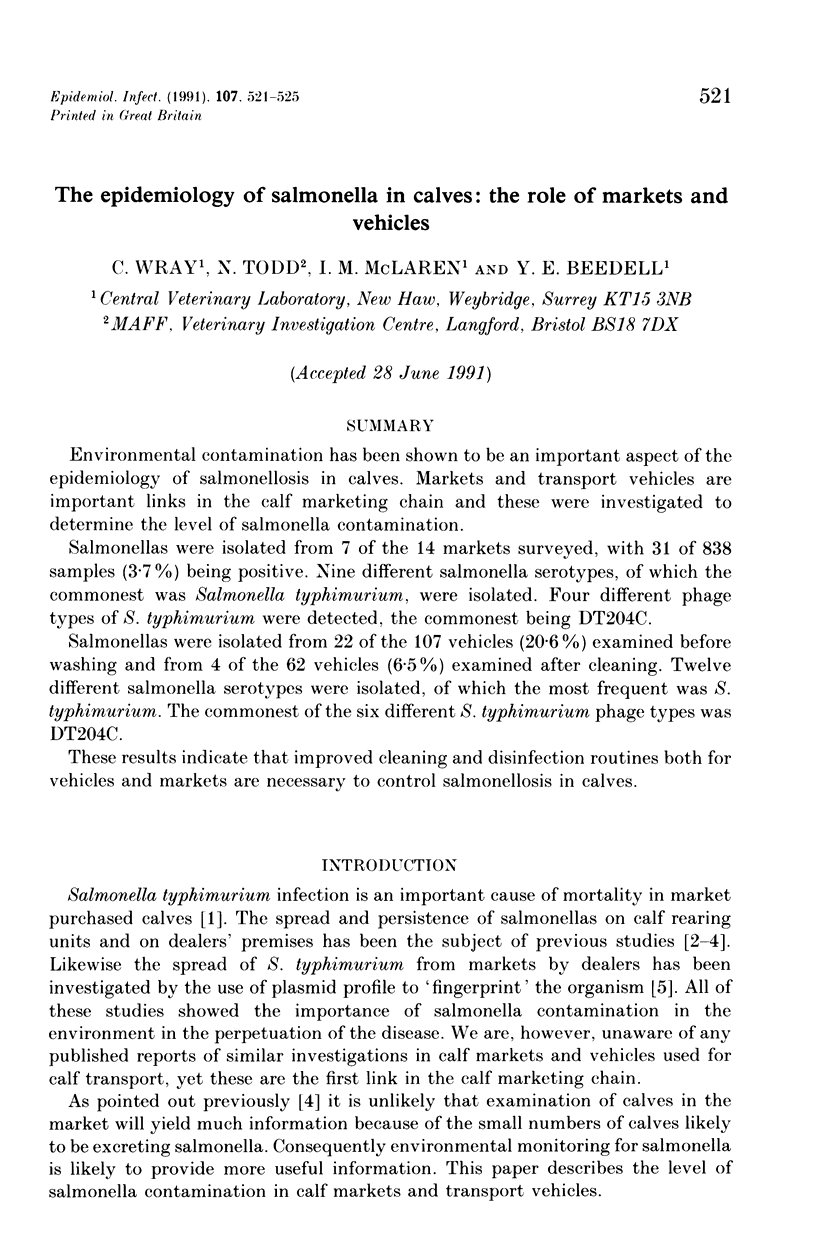Abstract
Environmental contamination has been shown to be an important aspect of the epidemiology of salmonellosis in calves. Markets and transport vehicles are important links in the calf marketing chain and these were investigated to determine the level of salmonella contamination. Salmonellas were isolated from 7 of the 14 markets surveyed, with 31 of 838 samples (3.7%) being positive. Nine different salmonella serotypes, of which the commonest was Salmonella typhimurium, were isolated. Four different phage types of S. typhimurium were detected, the commonest being DT204C. Salmonellas were isolated from 22 of the 107 vehicles (20.6%) examined before washing and from 4 of the 62 vehicles (6.5%) examined after cleaning. Twelve different salmonella serotypes were isolated, of which the most frequent was S. typhimurium. The commonest of the six different S. typhimurium phage types was DT204C. These results indicate that improved cleaning and disinfection routines both for vehicles and markets are necessary to control salmonellosis in calves.
Full text
PDF




Selected References
These references are in PubMed. This may not be the complete list of references from this article.
- Cole N. A., Camp T. H., Rowe L. D., Jr, Stevens D. G., Hutcheson D. P. Effect of transport on feeder calves. Am J Vet Res. 1988 Feb;49(2):178–183. [PubMed] [Google Scholar]
- Gronstol H., Osborne A. D., Pethiyagoda S. Experimental Salmonella infection in calves. 2. Virulence and the spread of infection. J Hyg (Lond) 1974 Apr;72(2):163–168. doi: 10.1017/s0022172400023354. [DOI] [PMC free article] [PubMed] [Google Scholar]
- Hinton M., Ali E. A., Allen V., Linton A. H. The excretion of Salmonella typhimurium in the faeces of calves fed milk substitute. J Hyg (Lond) 1983 Aug;91(1):33–45. doi: 10.1017/s0022172400060009. [DOI] [PMC free article] [PubMed] [Google Scholar]
- Williams L. P., Jr, Newell K. W. Sources of salmonellas in market swine. J Hyg (Lond) 1968 Jun;66(2):281–293. doi: 10.1017/s0022172400041140. [DOI] [PMC free article] [PubMed] [Google Scholar]
- Wray C., McLaren I., Parkinson N. M., Beedell Y. Differentiation of Salmonella typhimurium DT204c by plasmid profile and biotyping. Vet Rec. 1987 Nov 28;121(22):514–516. doi: 10.1136/vr.121.22.514. [DOI] [PubMed] [Google Scholar]
- Wray C., Todd J. N., Hinton M. Epidemiology of Salmonella typhimurium infection in calves: excretion of S typhimurium in the faeces of calves in different management systems. Vet Rec. 1987 Sep 26;121(13):293–296. doi: 10.1136/vr.121.13.293. [DOI] [PubMed] [Google Scholar]
- Wray C., Todd N., McLaren I., Beedell Y., Rowe B. The epidemiology of Salmonella infection of calves: the role of dealers. Epidemiol Infect. 1990 Oct;105(2):295–305. doi: 10.1017/s0950268800047890. [DOI] [PMC free article] [PubMed] [Google Scholar]


